Do you feel weird after drinking flavored sparkling water on an empty stomach? Find out about the new leeway the natural flavor industry has to add drug-like compounds to our drinks. I’ll focus on a natural flavor called linalool.
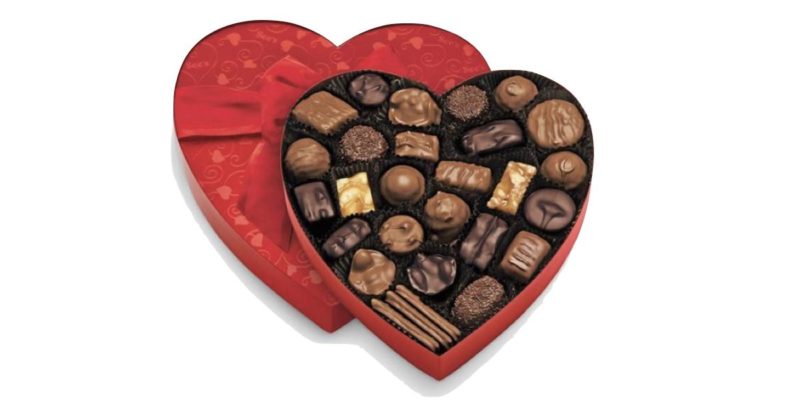
Valentine Chocolate: Saying “I love you” Without Lecithin
Table of Contents
- Is Dark Chocolate Healthier than Milk Chocolate?
- What Makes Expensive Chocolate Better than Cheap?
- Should I avoid chocolates made with “vegetable oil?” (The answer might surprise you)
- Should I avoid chocolates made with soy oil?
- What is Lecithin?
- Is Soy Lecithin Worth Avoiding?
- What is the most popular valentine chocolate?
- What is “Vegetable OIl”?
- Should I avoid chocolate with palm oil?
- What is Lecithin?
- Here are the top 3 most popular boxed chocolate hearts among American consumers, according to google:
- Here’s my ranking of “healthiest” to least healthy among the three top-selling valentine chocolate hearts, and why.
Finding the Best (Healthiest) Chocolate for Your Valentine
Unless your valentine is in the 10% minority of chocolate refusers, shopping for chocolate is in your February future. If you’re an ingredient reader, you’re going to run into lecithin. Lots of lecithin. Especially soy and sunflower lecithin. Many folks are wary of ingredients like lecithin. This article will discuss what it is, why its added, and what you need to know to find the best tasting and healthiest chocolate for the money.
We’ll cover
-
Is Dark Chocolate Healthier than Milk Chocolate?
-
What Makes Expensive Chocolate Better than Cheap?
-
Should I avoid chocolates made with “vegetable oil?” (The answer might surprise you)
-
Should I avoid chocolates made with soy oil?
-
What is Lecithin?
-
Is Soy Lecithin Worth Avoiding?
-
What is the most popular valentine chocolate?
Is Dark Chocolate Healthier Than Milk Chocolate?
You find articles promising dark chocolate will boost your immune system, lower your blood pressure, prevent heart attacks, protect your brain from Alzheimer’s, and more! I mean, c’mon folks, it’s candy. Dark chocolate is not healthy in the sense of you’ll get important nutrients from eating it, and as much as I love chocolate, most of those articles are wishful thinking, at best.
This article is continued below...(scroll down)
It’s called dark chocolate not because it’s got more chocolate, but because it’s got too little milk to be called milk chocolate. In other words, you can call any chocolate “dark” as long as it’s not milk chocolate. The term has no meaning beyond that, apparently. I feel somehow betrayed.
All else being equal dark chocolate doesn’t deserve higher nutrition marks than milk chocolate.
It is easier to find dark chocolate that’s lower in sugar, however, compared to milk chocolate. You easily tell if it’s a low sugar ‘dark chocolate’ by looking at the percent cacao. If it’s 80% or higher, that means 80% by weight is chocolate liquor, chocolate solids, or cocoa butter—stuff picked from a tree somewhere in the tropics. The 20% by weight is generally mostly sugar. When they add more cacao, the thing they usually subtract is sugar.
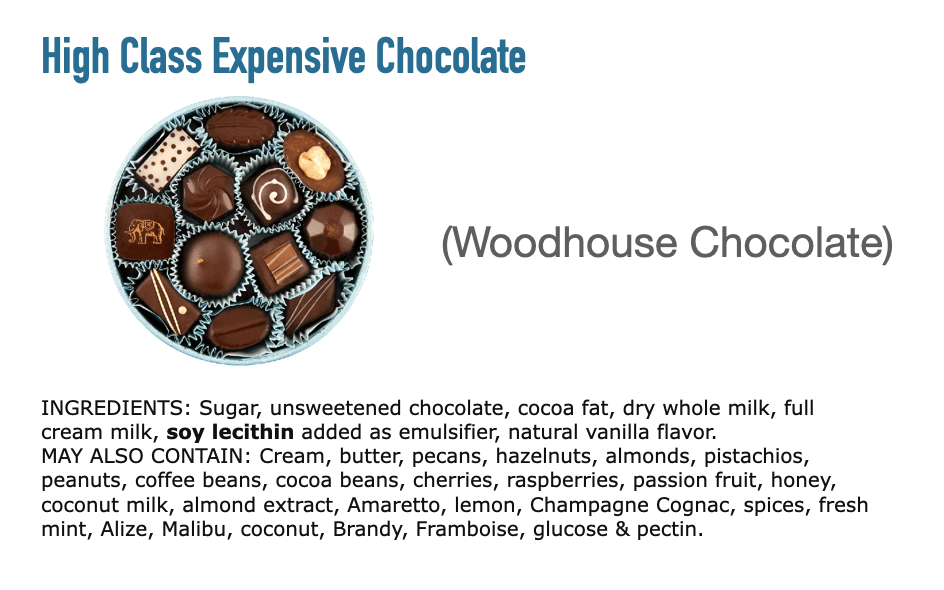
Is Expensive Chocolate any Better than Cheap Chocolate?
You may have grown up on cheap chocolate and like it better. That was me. Then I cured my sugar addiction. Now I’m a chocolate snob. I spend at least 10x more on each piece of chocolate, but each piece brings at least 10x more joy than cheap chocolate. And I eat less because it’s too darn expensive.
Sugar is the cheapest ingredient added to chocolate, and cheap chocolate contains much more sugar than better quality chocolate. The most expensive ingredient is fat. Cheap chocolate contains the cheapest fats and oils, usually something hydrogenated that shouldn’t be considered food. The mark of good chocolate is cocoa butter. Top-quality chocolates use only cocoa butter or cocoa fat, and cream.
So is expensive chocolate better? Yes. There’s more chocolate per calorie, and the fats tend to be of higher quality.
But unless you’re a major chocolate aficionado, you probably don’t need to empty your pockets for the super expensive stuff. The three most popular valentines chocolates I review down below are all pretty good quality chocolate. What you don’t want is something like this:
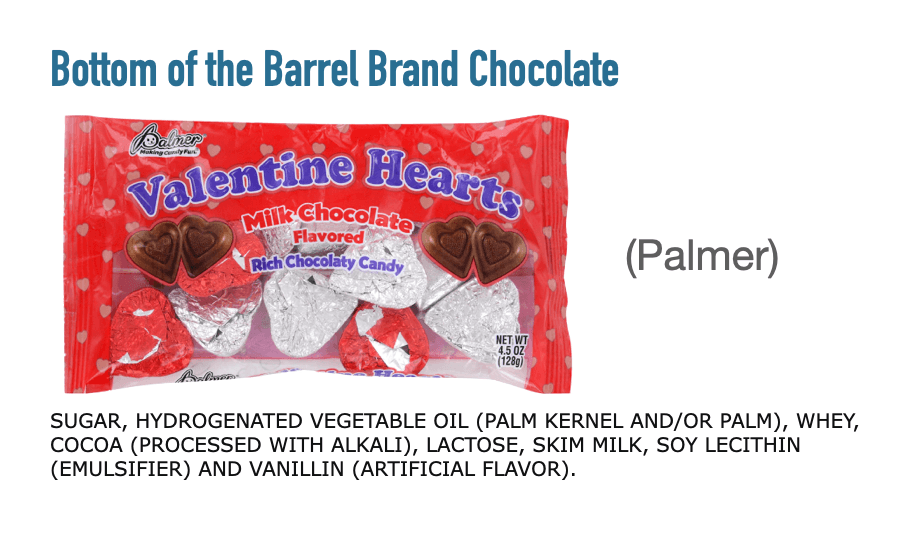
Should I Avoid Chocolates Containing “Vegetable” Oils?
A few “vegetable oils” you’ll find in chocolate are actually ok. So I want to take a moment to discuss the terminology.
What is “Vegetable OIl”?
Vegetable oil doesn’t come from vegetables like broccoli and carrots. Vegetable oil is a labeling term the FDA allows when the manufacturer wants leeway on exactly what oil will be added. It needs to be followed by a list specifying which oils might be added, and all oils must be similar in terms of their fatty acid profile.
Vegetable oils are not exactly the same thing as seed oils. Vegetable oil is a generic term for any oil that didn’t come from animals. What oil even comes from animals? Like nothing you’d ever eat (perfume oils, like mink and whale). So “vegetable oil” is a strange term that seems to exist to confuse everyone.
I’ve been writing about bad fats for years. All that time I’ve described bad fats as synonymous with vegetable oil. And until recently whenever the label said “vegetable oil” it listed one of the 3Cs and 3Ss listed here (under the red “don’t eat” column). But = lately, I’ve seen them using the term “vegetable oil” for palm and coconut. Palm and coconut can be healthy (more on that below). So now sometimes “vegetable oil” is healthy and sometimes it’s toxic.
What to do? Memorize the Hateful 8 toxic oils
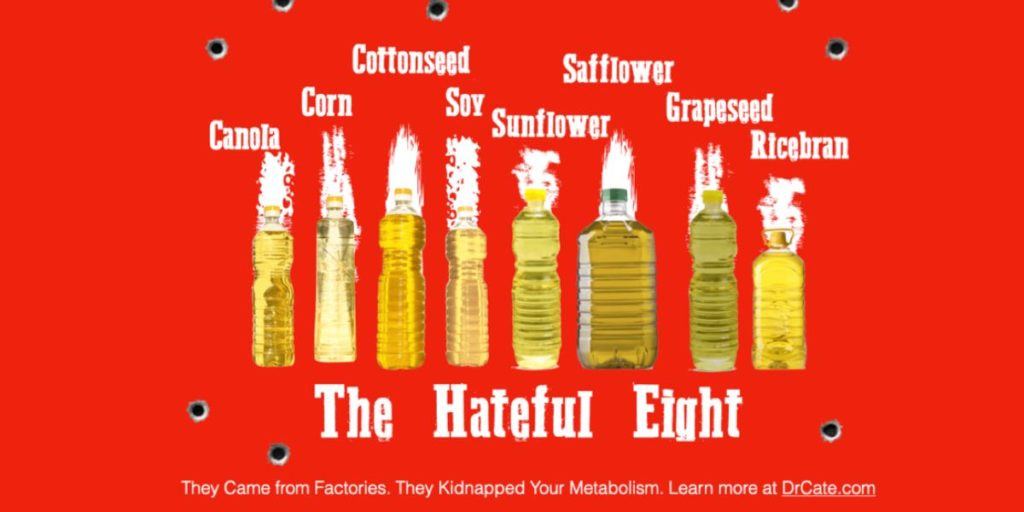
As you can see, the terminology is confusing. I think that’s part of the reason so few people have any clue at all about toxic oils! I recommend avoiding chocolate containing any of the Hateful 8 toxic oils because toxic oils are the most important category of toxins in our food supply. You need to know about them if you care about your health.
Should I avoid chocolate with palm oil?
Palm oil can be healthy, or it can contain cancer-causing glycidol. The difference comes down to factory processing, specifically the temperatures and whether or not it was refined. Unfortunately, there’s no way to tell how it was extracted and refined, even if it was refined at all. The best advice I can give you is if it’s expensive, it’s probably better. The chocolate company may put this information on their website, too.
Palm oil is also picked on for being environmentally disastrous. I say it’s being “picked on” because soy, corn, and all monoculture crops are also environmentally disastrous. We tend to get more worked up about environmental disasters in foreign countries than in our own. I guess we’re just terrific hypocrites.
Should I Avoid Soy Lecithin?
Soy lecithin is a disgusting ingredient that that’s impossible to avoid in boxed candy hearts currently on the market. I want to discuss whether it’s worth ever trying to find chocolate without it. Spoiler alert: no.
What is Lecithin?
Lecithin is added to chocolate because it’s an emulsifier, meaning it makes chocolate smoother. Specifically, it makes the sugar and chocolate blend together better. If a chocolate bar has very little sugar, the manufacturer may not need to add any soy lecithin.
Lecithin is one of those processed food ingredients that’s getting harder and harder to completely avoid, and being a byproduct of soy oil processing, it’s contaminated with highly toxic compounds. Don’t watch the video below of how it’s made or you might not want to eat chocolate again. The video shows crude soy lecithin being removed during a stage of soy oil processing that I call the diarrhea stage. The correct term is “degumming.” This loose, watery material gets processed into a canary yellow powder.
Fortunately, when it comes to chocolate, soy lecithin is almost never present at higher than 0.5% of the weight of the chocolate candy, and usually less than that. The reasons are 1) it’s expensive and 2) you only need a little dab to do the job. More than about 0.5% by weight, and you actually get clumpy, bad results.
Here are the top 3 most popular boxed chocolate hearts among American consumers, according to google:
1. Lindt Valentine Milk Chocolate Truffles
2. Godiva Chocolatiera Assorted Chocolate Valentines Day Heart
3. Dove Valentine’s Assorted Chocolate Candy Heart Gift Box 21gsugar/220 cal
Here’s my ranking of “healthiest” to least healthy among the three top-selling valentine chocolate hearts, and why.
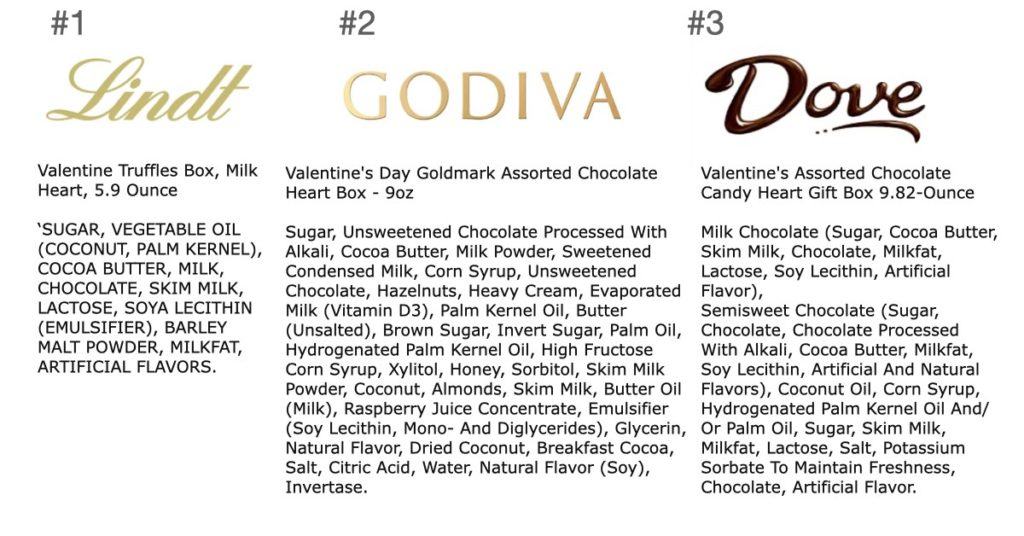
1. Lindt: No toxic oils and Less sugar than the others (14grams of sugar/220cal serving). Oddly, the label lists “vegetable oil.” Usually, that is a big no-no because, usually, that means one of the 3C or 3S toxic seed oils. Here, the oils used are palm kernel and/or coconut, both on the good fats list.
2. Godiva: More sugar than Lindt (20gm sugar/220cal). And better quality fats than Dove.
3. Dove: Slightly more sugar than the others (21gm sugar/220cal). And two kinds of hydrogenated fat.
Can you believe that the most popular is actually the healthiest? So it looks like Americans have good taste, at least when it comes to chocolate!
Please note: Please do not share personal medical information in a comment on our posts. It will be deleted due to HIPAA regulations.
This Post Has 14 Comments
Note: Please do not share personal information with a medical question in our comment section. Comments containing this content will be deleted due to HIPAA regulations.
















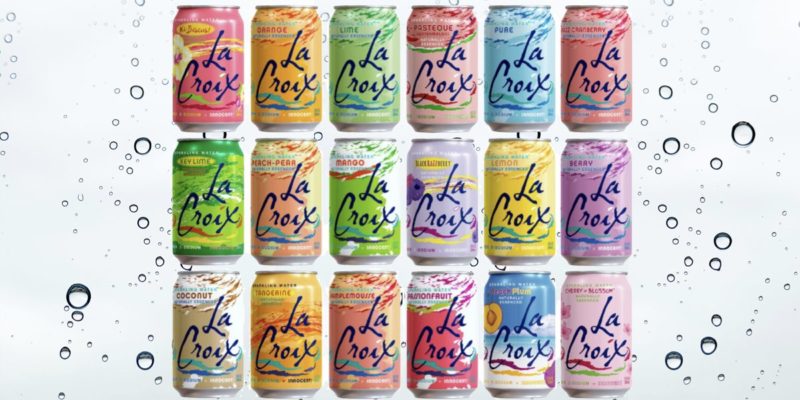
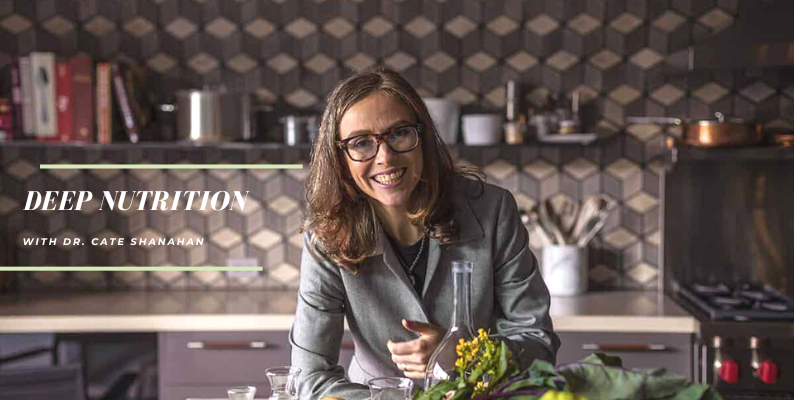
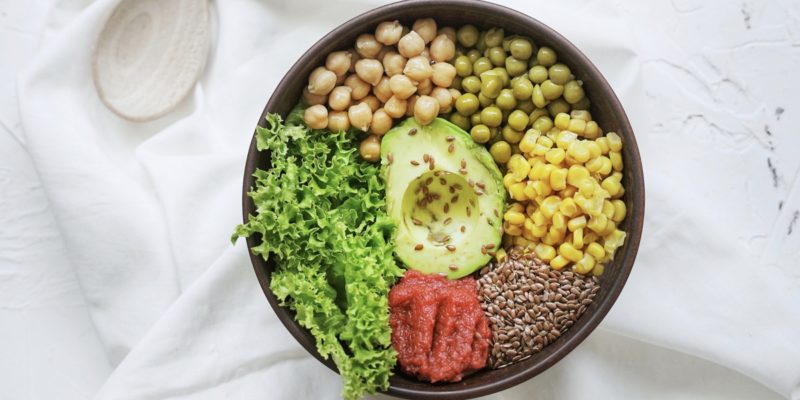
I have been searching for chocolate that does not contain soy lecithin but have not found any. I looked at European chocolate produced in Europe (they have higher standards of what’s allowed) using the European and Belgian branches of Amazon. Unfortunately, even the Belgians (who make the best chocolate in the world, IMHO) now use soy lecithin. The closest I’ve found is Lindt chocolate available in Europe. Soy lecithin is not listed in the ingredients, but there is a caveat that it “may contain soy”.
Hu chocolate is my favorite. It has no refined sugar, no cane sugar, no dairy, no sugar alcohols, no stevia, no soy lecithin and no sunflower lecithin. It’s delicious with 70% cacao. Organic Fairtrade as well.
I recall, maybe 40 years ago, when soy lecithin in a granular form was promoted to add to protein shakes as a health enhancer. If memory serves, I believe it was supposed to help with emulsification of cholesterol and fat in the blood. I recall advising my mom to take it when she was diagnosed with hyperlipidemia. Oh well. Live and learn. Regarding the candy, I’m now not impressed with either of your three examples. I’ll stick to making my own chocolate fat bombs, which include cocoa powder and coconut oil, butter, cream cheese and nuts.. Sometimes, I also throw in “natural” peanut butter, which is likely not a good thing, but may still be a better option than those you mentioned in this article. Thanks..
high oleic sunflower oil Great info. Thank you! Quick question on high oleic sunflower oil (May list organic sometimes)—promoted as the heart-healthy oil:
As bad as toxic sunflower oil?
Ok in moderation, or skip it altogether?
Since I’m GF, no sugar added, & now good oils for the last 2-3 years, it’s extremely difficult to find anything without all 3 categories (most healthier GF options contain high oleic sunflower oil) now—when it comes to anything crunchy it seems. How do we get FDA to recognize the dangers of hateful 8, to have best options for heart-health? Thanks for everything you do to help get the truth out behind AMERICAN disease cycle.
Learning about the hateful 8, my overall inflammation feels 200% better. At 62 I have returned to active competitive pickleball! The bad oils were def one of my main culprits. My BP is normal range again and I’ve raised my good Cholesterol so much that ratio is back in the green. I hope to get off statins altogether! As my muscles can barely tolerate statins—the only evil script I’ve taken in the last 4-5 years.
High oleic sunflower oil is “healthy” the way lower tar cigarettes are healthy. More info on that question on my list of good fats and bad page
Love your articles, including this one. Thanks for doing the hard work of figuring out the best nutrition for us!
Thank you Dr Cate for guidance on healthy indulging..esp during chocolate season:). My absolute favorite chocolate bars made without soy or sunflower lecithin and sweetened with coconut sugar are the chocolate bars from Vital Leaf. The Hazelnut & Sea Salt and Vanilla Bean Crunch are my favorite. (The crunch has popped quinoa, not rice). I think they’re both 73% cacao, so it’s not a super dark bar..but surprisingly creamy and a perfect level of sweetness.
Definitely recommend!
https://vitalleaf.com/shop/vanilla-bean-crunch-cbd-chocolate/
Thanks for sharing!
Hi Dr. Cate,
Thank you for the article. I have myself and my whole family avoiding the bad seed oils because your research in “Fatburn Fix” makes so much sense to us.
I’m still confused about palm oil. It’s listed on things we enjoy, like microwave popcorn, but it isn’t clear from your comments how we should handle the palm oil ingredient. We avoid the 8 baddies, but palm? We don’t know what to do.
Is there anything you can tell us about a listing of palm kernel vs. palm vs. refined palm? If it’s listed as just palm oil should we assume it isn’t refined or that it’s to be avoided?
Thanks again. We’re looking forward to your writings in the future
Unrefined palm kernel is better than unrefined palm which is better than refined palm kernel and refined palm, which are about equally “ok but not great.” More info on my list of good fats versus bad page.
Dear Dr. Cate
Although mono-culture crops an environmental problem in the U.S., the problem with palm oil and coconut oil is that they increasingly come from trees planted in the tropics. The rain forest is being cut down to make room for more and more palm and coconut trees. Since the rainforest is the lungs of the planet, humans are slowly strangling themselves in order to produce palm and coconut oil.
Yes. We are not behaving responsibly. Hopefully, there is another planet out there as beautiful as ours but with more-intelligent life.
Hi,
I was wondering about Sees cholate? Love Sees.
We saw you on the Bill Maur show we have been true believers. I have lost 35lbs. and my husband 20lbs. Thank you!
K
I love Lindt, but my favorite is Guittard! Unfortunately, they don’t sell chocolate bars for eating, only for baking. They do make chocolate chips though. Their cocoa rouge powder is best, and I end up making my own keto chocolate bombs.